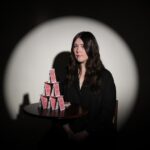Family wounds are usually the toughest to heal. Especially when there’s a presumably unforgivable act that alters the course of a mother and daughter relationship. Carly (Carly Pope) is faced with a difficult set of circumstances concerning her mother, Angela (Natalie Boltt) ad a young age. With that was a desire to forget the circumstances of her past and forge a new life and identity. Something draws her back. Her mother, who is in a coma, has been kept under the care of a mysterious company. A company with the technology that will allow Carly to speak to her mother through a digital construct built upon Angela’s memory. At first, reluctant, Carly goes through with it. Upon her look for answers, she finds a presence far more sinister than she could imagine.
Demonic, writer/director Neil Blomkamp’s first movie in almost seven years, tells a story of demons, both emotional and otherworldly. Using a new technology named volumetric capture, despite the film’s lower budget, there’s an electronic playground to be explored. It was a new process for Blomkamp and actress Carly Pope to navigate, especially in the age of COVID-19. Pope was able to channel her character’s anger and need for resolution as she explored the more digital elements of this sci-fi, horror mash-up.
We spoke to actress Carly Pope about working on Demonic and what she would do if she was in her character’s predicament.
I know you worked with Neil on Elysium together in 2013. How did it feel to circle back around in the lead for demonic? With the vo cap element, it was a new experience for both of you to work with. Was that initially hard to adjust to?
I think with every project that I’ve worked with Neil on, there’s been an element of surprise That’s always a part of the fun. It’s why I really enjoy working with him. You never really know what you’re going to get, but it’s guaranteed to be a good time. You’re also guaranteed to learn something at the end. Regarding the first part of your question, I worked on Elysium with him many, many moons ago. That was in a much smaller capacity. I think I was on set for like six or seven days.
It was a hugely scaled film. There was a massive crew, sets, and cast. We were able to work together more closely on the Oat Studios projects we had done. The old studio shorts. That’s when I felt like I really got to know Neil as a filmmaker, and creative mind. A person who just wanted to experiment and play in the sandbox. When Demonic came around, it was an incredibly flattering and humbling task to take on the lead. I really was just so excited to do it. It was an easy yes. There was no confusion about wanting to collaborate with Neil again and to do it on a larger scale.
Regarding the vo cap, yes, it was totally new. One short that we had done together for Oats Studios was called ADAM: The Prophet. That was my first time experiencing motion and facial capture. That was plenty strange, because the facial capture, in particular, you cannot move your face at all. So it’s like you’re emoting, but without the ability to move. It’s a very wild concept. I’d experienced, sort of, on route to the ball cap technology. I’d also come to understand a bit of photogrammetry, which was incorporated into that short as well. Some of it we used in Demonic.
I had a bit of an awareness of what was going on, but a minimal understanding of what it actually was and what it entailed. I think Neil had sent me a video of what the process and technology were. So, I had a bit of a visual understanding. As we went, he would show me mock-up models of things. Or show me the real environment that we were capturing for the photogrammetry element. We walked through the spaces and stuff. I felt like I was in school, which was great. It was exciting because I didn’t really know what I was going to learn that day. However, I knew it was going to be something. I feel like why do this if not to be challenged, and to learn something new?
Demonic is not your conventional possession horror film. It’s a lot of genres in one. One thing I was wondering when I was watching the film, especially with the vo cap, is that a lot of the emotional scenes happen in a digital space. Was that hard for you to channel those emotions given the filming style?
It was absolutely strange. You’ve got this very internal world that you’re trying to portray, or encapsulate, with a very external process. All the technology was very much exterior, but yet, I had to connect to the inner core of what was going on. I found that incredibly difficult. Mainly because I think I was just really distracted by the noise or by everything around me.
That said, it was so gratifying to settle in and figure out how to do that. When you’re shooting a film, there are plenty of distractions. There are distractions almost everywhere. To me, the hurdle was trying to get past that. Quieting the noise and doing the work. Natalie Boltt, who plays my mother in the film, is so extraordinary. She just got so much energy, moxie, and is such a generous actor. It was really a pleasure to be able to share that experience with her. Also, to hold each other up whilst we went because it was new for both of us.
Concerning your character, at the core, there’s a very complicated mother-daughter story. It’s built around a particular choice and how to move past it. Taking a step back without giving anything away, would you have made the same choices that Carly did in reconnecting with her mother?
Great question. To me, I always saw it as a story about forgiveness and healing. So, to get there, what are the things you have to do? What are the steps you have to take in order to get there? So much of it is about these subconscious traumas that then seep into our reality. So, again, would I do it? Yes. I feel like otherwise, how do you heal that trauma? How do you forgive yourself? Let alone somebody else that you have had this decades-old estrangement from or rift with?
I feel like so much of it is really inner child stuff. We want our parents. We want to feel protected and feel safe. So much of that was taken away from Carly early on. She has to contend with all the darkness within in order to see the light of day on the other side. I felt like I resonated with that concept and what she had to do to get there.
Photo Credit: IFC Midnight













